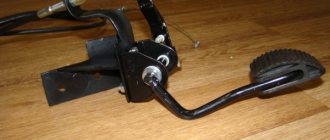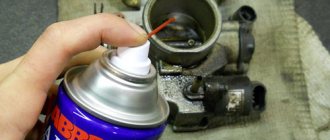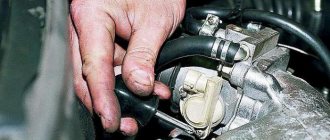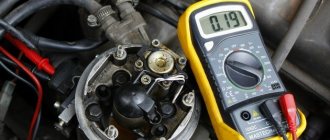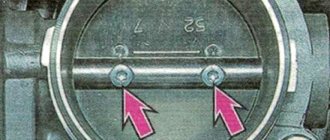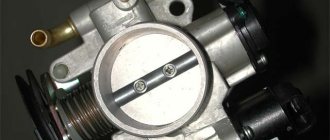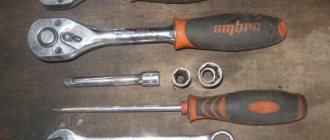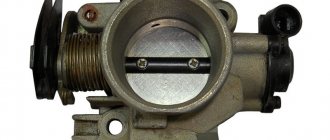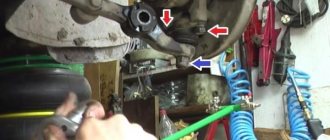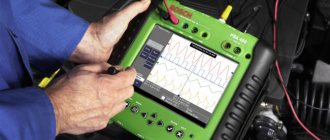Hi all! I hope the information from this post will be useful and will be useful to someone! Good luck on the roads and a full tank!
The “symptoms” of a faulty throttle position sensor include the following:
1. Increased idle speed. 2. The engine stalls in neutral gear. 3. Idle speed floats. 4. Jerks during acceleration. 5. Deterioration in dynamics. 6. In some cases, the Check Engine light may come on.
Diagnosis of the throttle position sensor is carried out as follows:
1. Turn on the ignition, then check the voltage between the slider contact and the minus with a voltmeter. The voltmeter should show no more than 0.7 V. 2. Next, turn the plastic sector, thereby fully opening the damper, then measure the voltage again. The device should show at least 4 V. 3. Now turn off the ignition completely and pull out the connector. Check the resistance between the slider contact and any terminal. 4. Slowly, turning the sector, monitor the voltmeter readings. Make sure that the needle moves smoothly and slowly; if you notice jumps, the throttle position sensor is faulty and must be replaced.
Replacing the throttle position sensor:
1. Disconnect the wire from the “–” terminal of the battery. 2. Disconnect the block with wires from the throttle position sensor by pressing the plastic latch. 3. Unscrew the two mounting screws and remove the throttle position sensor from the throttle pipe. 4. Install the new sensor in the reverse order, but do not forget about the foam ring. The throttle position sensor does not require any adjustment, since the controller perceives idle speed (i.e. the throttle valve is completely closed) as the zero mark.
The “symptoms” of a faulty idle speed sensor include the following:
1. Spontaneous unregulated change in engine speed (sudden decrease or increase). 2. When turning on a “cold” engine, there is no increase in speed. 3. When using additional vehicle devices (heater, headlights), the idle speed is simultaneously reduced. 4. The engine stalls at idle and when shifting gears. It is necessary to remember that the readings of the VAZ 2110 injector idle speed sensor are not “readable” by the automatic on-board power system, and it is not integrated into the “Check Engine” alarm system.
Diagnostics of the idle speed controller is carried out as follows:
There are several ways to analyze the idle speed sensor, but the main ones - the simplest and most effective - are the methods described below:
1. First you need to “get” to the device, disconnect it from the connecting block of wires 2. Using the most common voltmeter, check for the presence of voltage - the “minus” goes to the engine, and the “plus” to the terminals of the same block of wires A and D. 3. Turns on ignition, and the received data is analyzed - the voltage should be within twelve volts, if less, then most likely there are problems with the battery charge; if there is no voltage, then you will have to check both the electronic control unit and the entire circuit. 4. Then we continue the inspection with the ignition on, and analyze terminals A:B, C:D one by one - the optimal resistance will be about fifty-three ohms; During normal operation of the IAC, the resistance will be infinitely high.
Also, with the sensor removed and the ignition on, if you connect a power supply to it, the conical needle of the sensor should move out; if this does not happen, it means it is faulty.
1. Remove the negative terminal of the battery. 2. Disconnect the IAC from the block harness. 3. Using a multimeter, we measure the resistance of the external and internal windings of the IAC, while the resistance parameters of contacts A and B, and C and D should be 40-80 Ohms. 4. If the instrument scale is zero, it is necessary to replace the IAC with a serviceable one, and if the required parameters are obtained, we check the resistance values in pairs B and C, A and D. 5. The instrument must detect an “open circuit.” 6. With such indicators, the IAC is in good working order, and if they are absent, the regulator must be replaced.
If the problem lies precisely in the operation of the regulator, then you should not rush and immediately go to a car service center, since you can clean the idle speed sensor yourself, as well as replace it.
Cleaning and replacing the idle air control.
The first thing you need to do is purchase a carburetor cleaner, and then get down to business: 1. The wire block is disconnected from the sensor. 2. Afterwards, both of its fastenings are unscrewed, and the sensor is removed. 3. If necessary, the IAC is completely cleaned of possible debris and contaminants on the cone needle and spring. 4. Also, do not forget to clean the mounting hole on the throttle assembly, where the conical needle of the sensor enters. 5. After cleaning, install everything in its original location.
If nothing has changed in the operation of the car - the same problems and inconveniences are present - then the regulator should be replaced.
It is worth noting that when purchasing you need to pay attention to the end mark 04. Sensors are produced with mark 01 02 03 04, so look at the mark of the old sensor and purchase the same one. If you put, for example, a sensor labeled 04 instead of 01, the sensor will not work. The following replacement is allowed: 01 to 03, 02 to 04 and vice versa.
Replacing the idle speed sensor can also be done without any problems:
1. The on-board system of the car is de-energized. 2. The block with wires is disconnected from the XX regulator. 3. The screws are unscrewed and finally the sensor is removed. 4. Attach the new device in the reverse order.
If you are faced with a situation where the engine idles unevenly or the car periodically stalls for unclear reasons , then the fault of the power unit may be a malfunction of the throttle position sensor . You should not immediately go to a service station, because this problem can be eliminated on your own.
TPS design
The throttle position sensor is a device that is designed to accurately distribute the amount of fuel mixture entering the engine combustion chamber. Its use in modern engines allows increasing the efficiency of the car, as well as increasing the efficiency of the power unit. It is located in the fuel supply system on the throttle valve axis.
This is what the TPS design looks like
At the present stage of development of automotive technology, the following types of TPS are presented on the market:
Non-contact throttle position sensor with pin designation
The latter structurally have resistive contacts in the form of tracks along which the voltage is determined, while non-contact ones carry out this measurement based on the magnetic effect. Sensor differences are characterized by their price and service life. Contactless ones are more expensive, but their service life is noticeably longer.
Operating principle
As mentioned above, the sensor is located near the throttle valve . When you press the pedal, it measures the output voltage. In the case when the throttle valve is in the “closed” position, the voltage in the sensor is up to 0.7 Volts . When the driver presses the gas, the throttle axis rotates and accordingly changes the inclination of the slider at a specific angle. The sensor response is manifested in a change in resistance on the contact tracks and, consequently, an increase in the output voltage. When the throttle is fully open, the voltage is up to 4 Volts . The data is for VAZ cars .
These values are read by the vehicle's electronic control unit. Based on the data obtained, he applies changes to the amount of fuel mixture supplied. It is worth noting that this entire procedure occurs almost instantly, which allows you to effectively select the engine operating mode, as well as fuel consumption.
Tuning by replacement
The standard valve (throttle assembly) usually has a diameter of 46 millimeters; many fans of various tunings decide to replace this part with an alternative one:
- VAZ 2112 throttle valve 52 has a larger diameter (there are also valves of 54 and 56 millimeters)
- Is there any benefit from such tuning?
- In various online stores they often offer to replace the standard 46 mm throttle body (DU) and install 52, 54 or 56 mm
- The product description says that an enlarged throttle body (also known as the throttle body) leads to a decrease in air flow speed, which improves the performance of the air intake system
- The effect of installing an alternative damper will be clearly visible when using a zero-resistance filter in the system
- We recommend installing a unit with a diameter of 52mm, because... the diameter of its air inlet for a standard receiver is 53mm
Signs of sensor malfunction
When the TPS is in good working order, your vehicle operates without uncharacteristic jerking or jerking and quickly responds to pressing the gas pedal. If any of these conditions are not met, then there may be a sensor malfunction. This can be determined by the following signs:
- Starting the engine is difficult both hot and cold;
- Fuel consumption increases significantly;
- When driving, the engine jerks;
- At idle, the speed is often higher than normal;
- The car's acceleration is sluggish;
- Sometimes there are extraneous sounds similar to popping noises in the area of the intake manifold;
- The power unit may stall at idle;
- The Check indicator on the instrument panel blinks or stays on.
Most often, the sensor becomes unusable due to exceeding its service life due to wear-out. The contact group has a coating and, accordingly, it is characterized by wear. Those TPS that operate on a non-contact principle do not have this drawback and, accordingly, last much longer.
In order to finally make sure that it is necessary to replace this part, you need to be able to check the sensor .
Video on the topic:
Symptoms of pollution
- It becomes difficult for the engine to switch from high speeds to lower speeds and vice versa.
- The engine stalls while moving with shaking and has great difficulty restoring normal speed.
- The engine stalls at idle speed.
- Cold starting of the engine is difficult. In order to start the engine, you need to turn it with the starter for a long time.
- You will smell gasoline from the exhaust pipe.
- The first few minutes after starting the engine will “triple”.
It is recommended to clean the damper every 50-60 thousand kilometers . You should also periodically perform certain preventive actions.
Causes of pollution
A mixture of dust and oil particles slowly covers the surface of the valve during operation. This is especially noticeable in places where there are air turbulences.
If you do not clean it on time, then over time the thermal gap will become overgrown with such plaque. Also, the valve stroke in the damper, which regulates the idle speed of the car, will decrease.
Cleaning the damper
This work must be done with the engine turned off. You also need to wait until it cools down to avoid burns.
- Screwdriver Set.
- The key is "13".
- Rags (you can take ear cleaning sticks).
- Pad.
- Flushing liquid.
Step by step guide
- Initially, you will need to remove the protection from the engine.
- Next, you need to unscrew the plug from the expansion tank of the cooling system to reduce the pressure in it. Then you will need to loosen the clamps.
- The next step is to remove the forced ventilation hose of the air pipe. This element must be visually inspected. If oil is visible in it, then most likely the forced ventilation channel in the throttle valve is clogged.
- Next, use a screwdriver to loosen the damper heating pipes. They should also be turned off during work to prevent dust from getting inside.
- After this, the throttle assembly itself is removed. It looks like this:
- Now you need to directly clean the damper. To do this, you need to use carburetor flushing fluid and a rag. You can also use a metal knitting needle to clean the channels.
If necessary, the gasket must also be replaced. But when it is in its normal form, there is no need to change it.
After carrying out this work, the damper should be put back in place in the reverse order of disassembly. Next, you should start the engine and check its operation .
Checking TPS
Checking the throttle position sensor for VAZ 2110, 2114, Priora, Kalina, Renault Logan , etc. cars is carried out as follows:
- Turn off the car ignition;
- Use a voltmeter to check the sensor voltage, which is about 0.7 Volts when the damper is closed;
- Measure the output voltage with the damper fully open. It should be about 4 Volts;
- Check the uniformity of the voltage change by turning the sensor slider. In this case, there should be no jumps in values.
If there are deviations in the received data, the part must be replaced with a new one. In cases where the values coincide, the sensor is working and the breakdown should be looked for in other sensors.
Why is it needed?
The throttle position sensor is responsible for determining the current throttle position. Depending on this, the fuel supply system changes the amount of fuel supplied under one or another operating mode of the power unit.
If problems arise with it, you can contact a service station so as not to waste your energy and nerves. But in practice, changing the TPS yourself is quite simple, plus you will save a decent amount of money.
The desired regulator is located on the side of the throttle pipe on the throttle valve axis.
Features of work
The TPS is essentially a variable resistor, one output of which is supplied with 5 Volt power. The second contact is connected to ground, and the third is connected to the controller.
When you press the gas pedal, the voltage changes. The sensor monitors the output voltage on the controller, thereby regulating and monitoring the quality of the supplied air-fuel mixture. This directly depends on the opening angle of the damper itself.
If for some reason this regulator fails, a catastrophe will not occur, since another sensor, the mass air flow sensor, will temporarily take over its functions.
This does not mean at all that the TPS can not be changed. Each regulator has its own functions, so there is no point in transferring the tasks of the TPS to the MAF.
What is TPS in a VAZ-2110 car?
The throttle position sensor is abbreviated as TPS among motorists. This part is used in several types of engines:
- Gasoline injection type.
- Single injection type.
- Diesel engines.
TPS is also known as a throttle valve potentiometer. This is due to the fact that the sensor is designed to function as a variable resistor. The sensor itself is installed in the engine compartment - the place of fixation is the throttle pipe. The mechanism of operation of the sensor is as follows: depending on the position and degree of opening of the throttle valve, the resistance also changes. That is, the level of the value of such resistance depends on the pressing of the gas pedal. If the pedal is not pressed, the throttle valve will be closed and the resistance will be minimal. The opposite is true when the damper is open. Accordingly, the voltage across the TPS, which is directly proportional to the resistance, will also change.
The control of such changes is carried out by the electronic control system; it is the one that receives all signals from the TPS and supplies fuel using the fuel system.
So, at the maximum voltage of the signal contact of the throttle position sensor, the fuel system of the VAZ-2110 car will supply the largest portion of fuel.
Thus, the more accurate the TPS indicators, the better the VAZ-2110 electronic system adjusts the engine to the correct operating mode.
Repair work
Now to the question of how the cleaning procedure is performed. For everything to go smoothly and without problems, it is enough to prepare all the necessary materials and tools in advance, place everything at hand and get to work.
To clean the throttle you will need:
- Screwdriver Set;
- 13mm wrench;
- Throttle valve cleaner.
Specialized preparations made from appropriate components are sold specifically for these purposes. Do not spare money on their purchase, since the funds will last for a long time. This is more profitable than changing the damper every time.
Cleaning with special means
Preparation
Let's start with the preparatory activities that will ultimately allow you to get to the throttle body and more and clean it properly.
- Remove the casing that is installed on the power unit.
- Unscrew the cap on the expansion tank. This will allow you to relieve excess pressure from the cooling system.
- Slightly loosen the tension on the mounting clamps, then remove the forced ventilation tube.
- Examine the current condition of the air pipe, which should also be removed and, if necessary, replaced.
- If there are significant traces of oil in the pipe, then you can be 100% sure that the throttle is definitely clogged.
- The problem is most likely in the forced ventilation duct. This is explained by the fact that contaminants in the form of gas from the crankcase and oil particles have no other way than through the ventilation branch.
- Next you need to remove the damper heating tubes. To do this, just loosen the clamps with a screwdriver.
- For a while, come up with plugs for them from improvised means - old spark plugs, some kind of non-hollow rubber bands. In short, anything that fits the diameter of the hole.
- Remove the fuel tank ventilation system hose. To do this, you must first unscrew the clamp, remove the cable and unscrew the throttle mounting nuts.
- Be sure to remove the connectors from two sensors - idle speed and throttle position. They are located on the unit being repaired, so there will be no problems with the search.
Source
Communication of the throttle valve with other automotive systems of the VAZ-2110
The throttle valve of a VAZ-2110 car is a component of the engine intake system and is directly connected to a large number of other vehicle systems. These include the following systems:
- directional stability;
- anti-blocking;
- anti-slip;
- anti-slip;
- cruise control.
In addition, there are those systems that are controlled by the electronics of the gearbox. After all, it is this throttle valve that regulates the flow of air into the car system and is responsible for the quality composition of the fuel-air mixture.
Correction of a factory miscalculation
It is quite common for a throttle assembly to come out of the factory with something that cannot even be called a defect, but can still be attributed to design errors. In theory, air should flow into the space behind the throttle, for which a channel of approximately 2.5 mm is specially made.
But the whole problem is that this channel was pressed against the wall of the receiver, thus blocking the possibility of air flow. A slight modification of the throttle assembly can help in this case.
This material will help you install engine crankcase protection yourself: https://vazweb.ru/desyatka/dvigatel/zaschita-dvigatelya.html
Bored channel for air flow in the throttle
To do this, just take a file and use it to make a small groove in the indicated place. 2 - 3 mm will be enough. But before doing this, it is necessary to remove the throttle.
Characteristic symptoms of a malfunctioning TPS condition
Thanks to the correct functioning of the throttle position sensor, the fuel system of the VAZ-2110 car engine works with a smoothing effect. That is, the vehicle moves smoothly, and the gas pedal responds well to pressure. Therefore, a malfunction of the TPS can be noticed almost immediately by the following signs:
- Poor engine starting.
- Noticeable increase in fuel consumption.
- The car's movements are intermittent.
- The idle speed of the engine is noticeable when running.
- The Check e light comes on on the dashboard
- The car accelerates poorly due to delays in acceleration.
- Popping sounds are heard in the intake manifold.
Of course, these signs of a faulty sensor may not all be observed at once. But even if you notice only one of the above symptoms, it is worth carrying out computer diagnostics of the vehicle at a service center.
Step-by-step cleaning instructions
If the damper does get dirty, it doesn’t matter; with the help of several cleaning steps, the car’s operation will be restored. Before cleaning, you must remove the throttle assembly according to the following instructions:
- remove the corrugation;
- turn off the power supply to the sensors;
- push out the “weight” that secures the pedal cable;
- disconnect the coolant pipe;
- remove the ventilation hose; unscrew the assembly fastening;
- Unscrew the idle speed control.
To clean mechanisms, special products are required, in most cases aerosol cans. The best solution for this task is a carburetor or brake cleaner.
TPS problems and their diagnosis
As you know, eternal parts for cars have not yet been invented. And the breakdown of the TPS can be foreseen; for this you need to inquire about the possible reasons for the failure of this part. Here are the main ones:
- Abrasion of the sprayed base layer, which serves to move the slider (the result is incorrect TPS readings).
- Failure of the movable type core (the result is deterioration of the contacts between the slider and the resistive layer).
How can you figure out problems with this sensor yourself? To do this, you can independently diagnose the operation of your diagnostics:
- Listen to the VAZ-2110 engine idling:
- the breakdown is obvious if you notice that its speed is in a “floating” state;
- Quickly release the gas pedal:
- a malfunction is present if the engine stops after this action.
- Pick up speed:
- There is a problem with the TPS if the car starts to move jerkily, which indicates an incorrect supply of fuel to the system.
Experts say that most often the sensor fails when the resistive track is heavily contaminated or is completely broken. To verify the opposite, you need to check the working condition of the TPS.
Let's sum it up
| Supporters of replacing the remote control with a different diameter argue | Opponents of replacing the remote control with a different diameter argue |
| Replacement increases power and improves engine speed and gas pedal responsiveness | Washing or repairing a standard remote control gives similar effects |
| Does not affect gas mileage | Affects gas mileage, as everything is interconnected |
| Does not create problems in engine operation | Creates problems because the ECU cannot correctly adjust the ratio of air and gasoline in the mixture |
| Problems that arise can be solved with firmware | Problems are solved by flushing |
| Clearly, all tangible effects are associated with changing the remote control and are enhanced in combination with other improvements | Tangible effects are achieved by flushing the unit, and the use of other improvements improves the performance of the engine without replacing the remote control |
Here everyone decides for himself, we will not enter into disputes, there are simply different opinions, and we are obliged to warn about the pitfalls and the other side of the coin.
Checking the operation of the throttle position sensor
To check the TPS yourself, it is not necessary to call an auto electrician for consultation. To do this you need a multimeter or voltmeter. Next, experts offer step-by-step instructions for checking the sensor.
The first step is to turn the key in the ignition switch, take the voltage readings between the sensor slider contact and the minus. In normal condition, the indicator will be up to 0.7 V.
The second step is to turn the plastic sector and open the damper, and then take measurements again. In the normal state of the sensor, the device will show a result of 4 V.
The third step is to turn on the ignition completely (as a result of this the connector will stretch out), measure the resistance between the slider and any terminal. When rotating the sector, you must monitor the measuring device:
- when the multimeter or voltmeter needle moves smoothly, the sensor is working;
- when the needle on the meter shows sudden changes, the DPPZ is faulty.
Once the sensor is faulty, it can be adjusted or replaced. The VAZ-2110 car repair service center will tell you how to do the right thing.
Replacing the throttle position sensor on a VAZ 2110, VAZ 2111, VAZ 2112
Welcome! Throttle position sensor - it transmits readings to the controller (ECU) about what position the throttle valve is currently in; when you press the gas, the valve opens to a larger angle (Accordingly, you need to increase the fuel supply) and therefore the controller reads this (The sensor transmits readings to it) and increases the fuel supply to the cylinders, thanks to which the engine runs normally and without interruptions, unlike if the sensor fails (There will be serious problems with the operation of the engine, one of them is that it will not run The second one won’t really work either, the car will twitch when accelerating).
Note! To replace the throttle position sensor (abbreviated TPS), stock up on: A screwdriver, as well as a special one. a device with which you can check resistance (Ohm) and Voltage (Volt), such a device can be a multi-meter or an Ohmmeter with a Voltmeter separately, in addition to this, you will also need wires with bare ends (Or so that there are alligators at the ends) and that’s all, essentially, the latest devices and the wires are only needed to check the TPS for serviceability, if you don’t need this, then you don’t even have to buy anything like that, but just a sensor and a screwdriver so you can remove it!
Where is the throttle position sensor located? It is very easy to find, just open the hood and look for the throttle assembly, when you find it, look for two sensors on the side of it, one will be installed a little lower, and the other a little higher, and this is the one above (Indicated by a red arrow in the photo below ) is located and will be the TPS, but that’s not all, there is a foam ring under the sensor (see small photo), it must be replaced with a new one and therefore when you come to the auto store, don’t forget to buy it if it’s included with the TPS didn't work for you.
When should I replace my throttle position sensor? First, let's talk about the symptoms, they are as follows: The car's fuel consumption increases, Idle Speed (Idle) starts to work, I don't understand how (As a rule, it rises or just floats and the car does not work stably on it), and jerks may also appear during acceleration , the car may periodically stall while driving and, of course, “CHECK ENGINE” may light up for you (But this may not happen at all).
We’ve sorted out the symptoms, but let’s say right away that they are inherent not only to this sensor, but can also be attributed to the DPKV (They are identical there), so if your car has them, it’s simply stupid to go and buy a new DPZ right away, because the engine didn’t work as it should. it can continue to work steadily in the same way, in this case the sensor is checked for serviceability (The easiest way, in order not to bother, is to check the sensor by replacing it with an identical one, and the identical one can be removed from the same injection system of a friend, for example, or from the seller will agree to install a sensor, see if the engine’s performance will change and if it changes, then buy it), if you don’t have such a chance (Find an identical sensor), then special. the device will be needed, we don’t see the point in explaining in words how to check the sensor using a multi-meter, because it’s long, it’s better to watch the detailed video that is posted below, it shows the whole test, if something is not clear, then ask your questions using the comment form below and we will answer you as soon as we can.
Symptoms of pollution
- It becomes difficult for the engine to switch from high speeds to lower speeds and vice versa.
- The engine stalls while moving with shaking and has great difficulty restoring normal speed.
- The engine stalls at idle speed.
- Cold starting of the engine is difficult. In order to start the engine, you need to turn it with the starter for a long time.
- You will smell gasoline from the exhaust pipe.
- The first few minutes after starting the engine will “triple”.
It is recommended to clean the damper every 50-60 thousand kilometers . You should also periodically perform certain preventive actions.
Causes of pollution
A mixture of dust and oil particles slowly covers the surface of the valve during operation. This is especially noticeable in places where there are air turbulences.
If you do not clean it on time, then over time the thermal gap will become overgrown with such plaque. Also, the valve stroke in the damper, which regulates the idle speed of the car, will decrease.
Cleaning the damper
This work must be done with the engine turned off. You also need to wait until it cools down to avoid burns.
- Screwdriver Set.
- The key is "13".
- Rags (you can take ear cleaning sticks).
- Pad.
- Flushing liquid.
Step by step guide
Decorative protection on the engine and its attachment points
Clamps holding the pipes through which the mixture is supplied to the throttle valve
Forced ventilation hose with traces of oil in it
Damper heating pipes
The throttle valve removed from the engine is dirty
Flushing the unit using carburetor cleaning fluid
Cleaning channels with a metal knitting needle
If necessary, the gasket must also be replaced. But when it is in its normal form, there is no need to change it.
After carrying out this work, the damper should be put back in place in the reverse order of disassembly. Next, you should start the engine and check its operation .
How to replace the throttle position sensor on a VAZ 2110-VAZ 2112?
Removal: 1. First, simply press out the latch that holds the wire block and then disconnect the block (see photo 1), insert the key into the ignition and turn it until all the devices light up, then turn on the device, namely the Voltmeter function and from device, place the minus probe (it usually comes in black) to ground (the ground can be the car body or engine), and connect the plus probe to terminal A of the wire block (All terminals on the block are marked, look carefully) and the device should give a reading of approximately 5 Volts, but in no case less, if this is the case, then everything is in order with the wiring and most likely the sensor itself is to blame, if the voltage is less, then either the controller is faulty or there is a problem with the wiring, after the operation, turn off the ignition don’t forget, and when the wiring is checked, you can start replacing the sensor with a new one, for which unscrew the two screws that secure it to the throttle body body and then remove the sensor, under it there will be a foam ring that must be replaced.
Note! If you are going to change the sensor, do not forget to remove the minus terminal from the battery, how to do this, read the article: “Replacing the battery on VAZ cars”, point 1!
Installation: The sensor is installed in the reverse order of removal; when installing, its leads should be directed towards the engine shield. To make sure that the sensor will be installed correctly, lean it against the throttle assembly and make sure that the holes for the screws in the sensor coincide with the threaded holes in body and then fully open the throttle valve using the sector (or the gas pedal, let an assistant gently and slowly press it all the way), if everything goes well, the throttle valve will open completely and you can then tighten the sensor mounting screws until they stop.
Additional video: Visually watch the process of replacing the TPS in the video below:
Cleaning the idle speed sensor itself
Pay attention to the sensors on the ring, which must remain in place.
- Clean all parts of the throttle valve, all recesses and compartments.
- When everything is cleaned, we put everything in reverse order.
- We tighten everything well, otherwise air will leak and the engine will not work properly.
- You shouldn't have any difficulty. You have to be attentive and careful.
Throttle position sensor VAZ 2112
The sensor itself is a potentiometer (+5V is supplied to one end, and the other goes to ground. The third pin (from the slider) goes the output signal to the controller). When there is an impact on the accelerator pedal, the throttle valve rotates and the voltage at the TPS output changes (it is 4V when the throttle is closed). Thus, the controller monitors the TPS output voltage and adjusts the fuel supply depending on the throttle opening angle.
How to check
To check the throttle position sensor, we will need the following tools: a multimeter (ohmmeter, voltmeter), pieces of wire.
Having opened the hood, we find the sensor we need (we look for it on the throttle assembly next to the IAC).
Disconnect the wire block from the sensor
Take a multimeter and set it to voltmeter mode. Volts negative terminal (on the engine). We connect the positive terminal of the voltmeter to the sensor wire block to terminal “A” (the pin numbering is indicated on this wire block)
Turn on the ignition and check the voltage: the voltmeter should show a voltage of around 5 volts. If the voltage is not supplied, or it is much lower than 5 volts, then the problem is either an open circuit or a malfunction in the electronic engine control system (in the brains). But if the voltage is normal, then, accordingly, the TPS is faulty.
Conclusion: If the sensor is faulty, then there are two options to solve the problem:
1) Repair the sensor (How to repair the TPS?). Most often it is easier to replace the sensor with a new one, because The cause of failure is most often normal wear of the part.
2) Replace the sensor with a new one
The speed sensor on the link does not work.
Removing the unit
The purpose of the throttle assembly (abbreviated as DU) is to regulate the air supply to the engine cylinders. Thus, it controls the enrichment or leanness of the fuel mixture. The appearance of remote control malfunctions causes improper operation (interruptions) of the motor. If problems arise, the remote control is usually replaced with a new one, but often such problems are solved by removing and washing the remote control yourself.
What you need for cleaning
To remove and clean the assembly you will need:
- Screwdriver Set
- Head "13" with ratchet
- Old toothbrush with stiff bristles
- Cleaner
- Cotton swabs
- Latex gloves
- We remove the terminals of the VAZ battery, de-energizing the electrical network of the motor
- Disconnect the connectors from the throttle position sensor, idle speed control, and also remove the cable from the throttle valve actuator
- To avoid losses, partially drain the coolant
- Then loosen the clamp securing the air hose to the throttle body
- Then a clamp securing the ventilation hose of the 2nd circuit (crankcase gases) to the pipe on the cylinder head cover
- Now you can remove the air hose along with the crankcase ventilation hose
After releasing the clamps, remove the air hose
- Take a Phillips screwdriver and loosen the clamp, then remove the hose for crankcase ventilation (from the 1st circuit) from the remote control fitting
- Then we loosen the clamps securing the hoses that discharge and supply coolant, and remove these hoses
- Now, using the “13” head, unscrew the nuts that secure the throttle assembly to the receiver, photo below
Using a ratchet and a socket “13”, remove a pair of nuts that secure the unit to the receiver
- Then we remove our throttle assembly from the studs and loosen the clamp to disconnect the hose for purging the adsorber (this is necessary if your car has a system for collecting fuel vapors)
- Carefully remove the sealing gasket under the assembly
- If you have never carried out the steps to clean the remote control, then it will most likely be necessary to replace the gasket
- Then we unscrew the screws that hold the IAC (idle speed regulator) and then remove the regulator (don’t worry, the holes for attaching the regulator are designed in such a way that it will not be possible to mix it up when installing it)
